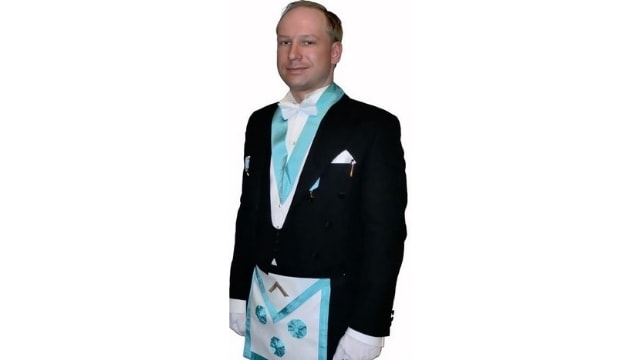After ten years, Anders Breivik is still called by some a “Christian fundamentalist.” But who is he and what motivated the man who carried out the Utøya massacre?
by Massimo Introvigne*
*This article collects, for ease of reading, a series of articles published on this site in September 2021.
Table of Contents
What “Religious” Ideas Motivated Breivik?


Anders Behring Breivik perpetrated the worst terrorist attack in the history of Norway ten years ago, in Oslo and the island of Utøya on July 22, 2011. He killed 77 innocent victims. Events are still continuing in Norway to commemorate them.
Respect and prayer are certainly due to all victims. Those who ask to reflect on the vigilance measures that even societies, such as those in Scandinavia, which value their “open” character, should adopt to protect themselves against multiple forms of terrorism are not wrong. It is normal that the roots of terrorism are also investigated, and that a discussion on what ideology motivated Breivik continues. We know what Breivik was against, Islam. His was a vicious, deadly form of Islamophobia. But was he in favor of any religion? He is often called a “fundamentalist,” or a “Christian fundamentalist,” but are these labels correct?
“Fundamentalist” is often used in a generic and imprecise way to indicate anyone with extremist ideas, or generically “right-wing,” with a vague reference or even no reference at all to religion. The Vienna-based Observatory of Intolerance and Discrimination against Christians in Europe has repeatedly denounced the dangers of a cavalier use of the term “fundamentalism” as an instrument of anti-religious and anti-Christian discrimination.
The expression “fundamentalist Christian,” of course, has a precise meaning. It dates back to the publication in the United States between 1910 and 1915 of the pamphlets The Fundamentals, a militant critique of liberal Protestant theologies, of the historical-critical method in the interpretation of the Bible, and of biological evolutionism. A fundamentalist is a Protestant who insists on the literal and traditional interpretation of the Bible, rejecting any hermeneutical approach that relies on modern social sciences, and from this interpretation deduces ultra-conservative theological and moral principles.
While initially applied to Protestants only, the term has been used analogically, although not uncontroversially, for members of other religions who interpret their sacred scriptures in a conservative, literal, and moralistic ways. Since Breivik was formally a member of the Lutheran Church, however, it is his relationship with Protestant fundamentalism that should be investigated.
We know Breivik’s ideas from the Facebook profile he kept before the terrorist attacks, and then deleted, but not before someone had saved it and put it online, from over sixty pages of interventions on the Norwegian anti-Islamic website document.no, and especially from his 1,500-page book 2083: A Declaration of European Independence, signed “Andrew Berwick,” sent to a number of friends and newspapers on July 22, a few hours after the massacre, and first posted on the Internet on July 23 by Kevin Slaughter, an ordained minister in the Church of Satan (who did not agree with its content).
Breivik and Freemasonry
A main interest of Breivik was Freemasonry. Those who visited Breivik’s Facebook profile were struck by a photograph that depicted him in a Masonic apron as a member of a lodge of St. John, one of the lodges that administer the first three degrees in the Norwegian Order of Freemasons, the regular Freemasonry of Norway. Breivik was a member of the Søilene, one of the lodges of St. John in Oslo of this Order. Breivik posted the photograph in 2011, the year of the bombings, and in 2009 on document.no Breivik advertised a fundraiser “in my lodge.”
Of course, Freemasonry had nothing to do with the terrorist attacks, and Breivik’s ideas do not in any way represent these of the Norwegian Order of Freemasons. The St. John lodges of the Order practice the so-called Swedish Rite, which requires members to be of the Christian faith. But no Protestant fundamentalist would ever spread photographs of himself in Masonic garb: fundamentalism is normally hostile to Freemasonry.
Breivik’s passion for the online role-playing game World of Warcraft and the vampire TV series “Blood Ties,” as well as his avowed friendship with the operator of Norway’s leading site promoting casual sexual encounters, are again not crimes, but at the same time are traits one would not find in the average fundamentalist Christian.
If one part of his book seemed to appreciate traditional family values, elsewhere Breivik declared that he was in favor of aborting babies with “mental or physical disabilities,” and had “set aside two thousand euros that I intend to spend on a high-quality escort, a real model, a week before the execution of my [terrorist] mission.” He wrote that “screwing around outside of marriage is after all a relatively small sin.” Definitely, he was not your typical Christian fundamentalist. But did he have a religion? We will try to answer this question later in this article.
Breivik, Christianity, and Islam


In the part of this article article, written in the tenth anniversary of the deadly terrorist attacks perpetrated in 2011 in Utøya and Oslo by Anders Behring Breivik, I explained why calling Breivik’s ideology “fundamentalist” or “Christian fundamentalist” is wrong. In this second part, I explore Breivik’s ideas on religion based on his published writings.
Breivik’s writings, which reveal extensive though messy readings, do not appear to be those of a simple madman, although there are traits of megalomania and obvious contradictions. Breivik’s main interest was not any religion he had positively embraced, but a religion he hated, Islam, which threatened, he says, to overwhelm with immigration Europe, and even more so a small country like Norway. These ideas were not, of course, particularly original, but were presented with tones that quickly became violent and paranoid.
Breivik’s primary goal was to fight Islam, hence his aversion to the Norwegian government, perceived as favoring indiscriminate Islamic immigration. For this crusade, he sought allies everywhere.
He said that he had voluntarily chosen to be baptized and confirmed in the Norwegian Lutheran Church when he was fifteen, since his family, rich and agnostic, had left him free to choose. He also reported that he soon concluded that the Protestant churches are now dead as they have succumbed to multiculturalist and pro-Islamic ideologies. At first, he wrote, he believed that Protestants should join the more conservative Catholic Church. But then he read Catholic literature, and concluded that the Catholic Church had sold out to Islam as well.
Remarkably, he wrote this at the time of Pope Benedict XVI, not of the more liberal and pro-immigration Pope Francis. His book threatened Benedict XVI, writing that “he has abandoned Christianity and European Christians, and must be considered a cowardly, incompetent, corrupt and illegitimate Pope.”
This is paradoxical since Benedict XVI was attacked by Muslims for his criticism of Islam in a speech he pronounced in Regensburg, Germany, in 2006. Indeed, Breivik said the speech gave him some hope, but then he concluded that the German Pope “seems to embody elements of both the sensible and the silly Christian ways of dealing with the Islamic threat.” When the Pope offered an apology of sort to the Muslims, Breivik saw the “silly” part prevail, and wrote that Benedict had abandoned “any shed of integrity,” and should be dethroned.
Once the Protestants and the Pope will have been both eliminated, Breivik wrote, a “Great European Christian Congress” will be organized, from which a completely new, anti-immigration and anti-Islamic “European Church” will be born. This church will not be “fundamentalist,” though. It will not insist on literalist Bible theology or strict morality, and will unite Europeans around the fight against immigration and Islam.
The “European Church” will be granted a religious monopoly in the new Europe but in turn, Breivik wrote, “the Church and church leaders will not be allowed to influence non-cultural political matters in any way. This includes science, research and development and all non-cultural areas which will benefit Europe in the future. This will also include all areas relating to procreation/birth/fertility policies and related issues of scientific importance.”
If Breivik had an enemy, Islam, he also had an imaginary friend, the Jewish world, which he considered the safest anti-Muslim bulwark. The terrorist had a true cult for the State of Israel and its military forces, to which corresponded, surprisingly, a lively aversion to Nazism. “If there is a figure I hate, he wrote, it is Adolf Hitler.” He even fantasizes about time travel and the possibility that he could travel to the past and kill Hitler.
Breivik did subscribe to a Nazi web forum, but his postings there tried to persuade other participants, not surprisingly without success, that if some of the Führer’s ideas on the ethnic primacy of the Westerners were right, Hitler’s unforgivable mistake was not to understand that the purest and noblest Westerners are the Jews, and that if it had wanted to exterminate someone, Nazism should rather have gone after the Muslims in the Middle East.
A frequent reference is also to the English Defence League, an anti-Islamic British movement that is regularly accused of being racist, and just as regularly disputes this accusation and criticizes neo-Nazism. Breivik wrote that he was no racist either, but multiculturalism is a form of racism, and “you can’t fight racism with racism.”
Nazism, Communism, and Islam are for Breivik three faces of the same anti-Western doctrine, and all three should be outlawed. “For me it is very hypocritical to treat Muslims, Nazis and Marxists differ [sic], he wrote. ALL hate ideologies should be treated equally.” But his emphasis was always on fighting Islam.
Anyone who was an actual or potential enemy of Muslims became Breivik’s possible ally. He invited secular humanists, who are an important presence in Norway, to fight Islam rather than Christianity only. He invited homosexuals to join his anti-Islamic crusade as well, pointing out that in a world dominated by Muslims they will be persecuted.
He invited the Roma, to whom unlike other anti-immigration activists he was quite sympathetic, to understand that their wretched condition derives from having once been enslaved in Asia by Muslims (a pseudo-historical theory), and they have now an opportunity to react and fight Islam. He also quoted the ideas of the predominance of the strong over the weak and the virtues of savage capitalism advocated by novelist Ayn Rand, a self-proclaimed atheist.
He had other more esoteric references, too.
Breivik, Anglo-Israelism, and the Knights Templar


At the beginning of this article, we saw how it is difficult to classify the ideas that motivated Anders Behring Breivik, the terrorist of the deadly attacks perpetrated in Norway ten years ago, in 2011, as “fundamentalist” or “Christian.”
Breivik regarded as his inspiration the Norwegian anti-Islamic blogger Fjordman, whose real name was Peder Are Nøstvold Jensen. The relationship was not reciprocal. At least after the terrorist attacks, Fjordman wrote that Breivik was a psychopath, he disliked being quoted by him, and death penalty should be reintroduced to execute him. Fjordman’s ideas did not promote any religion, only advocated a common European resistance against Islam.
If anything, a “religious” tone can be found in his fervent defense of the Jews and the State of Israel. This is a theme that also emerges in some fundamentalist Protestant groups, based on the idea that Israel is a state willed by God in view of the end of the world, but Breivik’s accents were different. Even if they lack direct references, they recall Anglo-Israelism, a current born in the 19th century in Great Britain and with ramifications in Scandinavia. Anglo-Israelism believes that the original inhabitants of Northern Europe were “Jews,” descendants of the lost tribes of Israel. The name “Danes,” for example, would indicate the tribe of Dan.
The Anglo-Israelite movement split in the 20th into different factions. One faction claims that Northern Europeans are today the only authentic “Jews.” Those who call themselves Jews, in Israel and elsewhere, are not ethnically so, since they are mostly Khazars, members of a Central Asian tribe converted to Judaism in the 8th and 9th centuries CE. Hence the aversion of this faction against Israel, believed to be a Khazar state, and its links with anti-Semitic and neo-Nazi groups.
Another faction, on the contrary, believes that Jews as we know them today are true heirs of the tribe of Judah, waiting to be reunited with their Anglo-Saxon and Scandinavian brothers of the lost tribes. Those who hold this view consider the Northern Europeans brothers of the Jews and, far from being anti-Semitic, defend Judaism and the State of Israel, often in a very heated way. It is this second faction that is historically prevalent in Scandinavia, and it may have inspired Breivik.
According to his book, in 2002 the terrorist founded with others in London a neo-Templar order that joined the many that already existed, the Poor Soldiers of Christ and of the Temple of Solomon (PCCTS), inspired both by the Catholic Knights Templars of the Middle Ages and by the Knights Templar degrees of Freemasonry. It was open to members of all faith except Islam, at the condition that they opposed Muslims. Whether the PCCTS ever had any member in addition to Breivik, and had been really founded in London at a ceremony attended by nine knights, remains unclear.
Breivik’s “Templar executioners,” according to his book, should operate in three phases of a “European civil war.” In the first (to be concluded in 2030) they should awaken the sleeping conscience of Europeans by means of “shock attacks of clandestine cells,” unleashing “groups of individuals who use terror”: small cells, even of just one or two people.
In the second phase (2030–2070), they should move on to armed guerrilla warfare. In the third (2070–2083), real war against Muslim immigrants should start. Breivik was aware that the attacks of the first phase would transform those who would carry them out into terrorists hated by all, but this, he believed, would be a mystical form of “Templar martyrdom,” embodying the true spirit of the Order.
The targets of the “shock attacks” should be political parties: first of all the Norwegian Labour Party, but parties in other countries perceived as pro-Islam and pro-immigration were also named. There were also threats against the Vatican and Pope Benedict XVI, and the OSCE (Organization for Security and Cooperation in Europe).
Breivik reported that at the time of the attack his Order had members in various European countries, including some in Serbia the word called “war criminals” but who were in fact heroes of the anti-Islamic fight.
But was he writing a novel in the style of Sweden’s Stieg Larsson or describing a real organization? Other autobiographical details of the book that seemed improbable, including the presence of diplomats in his family, and the fact that he attended elite schools as a boy, were confirmed by the Norwegian investigation. That he was the leader of a really existing international movement, on the other hand, was not confirmed.
One part of Breivik’s book looks like a manual for terrorists, accompanied by a diary on the preparation of the attack. It reveals detailed knowledge of weapons, explosives, the new terrorist technique called “open-source warfare,” which can be implemented even by very small groups, and bulletproof clothing, including socks, a detail Brevik claimed many wannabe terrorists overlook to their peril, and to which he devoted several pages.
Breivik always wrote in a paranoid tone. If we look for a method in his madness, we will find it only in a virulent opposition to Islam. Although Breivik would have considered Christians, or anybody else, willing to fight Islam as potential allies, Christianity per se, “fundamentalist” or not, had very little to do with his project.
In 2015, from jail, he wrote that definitely he was “not a Christian,” and called Jesus and his message “pathetic.” If with anything, he identified himself with neo-paganism and Odinism. But these might have been just additional labels he was putting on his self-constructed religion of Islamophobia, which was never in favor of any tradition, just against Islam.







